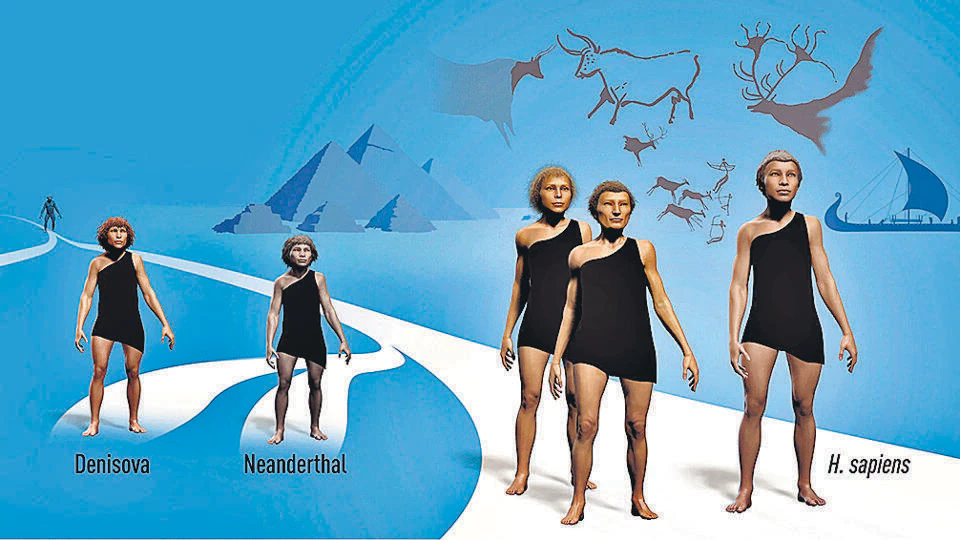What makes human beings human is a Nobel Prize Winner’s mission to discover. What makes us different from our closest relatives, the now extinct Neanderthals and Denisovans, and what do we have in common with them?
The Nobel Prize in Physiology or Medicine, awarded to Swedish geneticist Svante Paabo on Monday, recognises work that explored these questions which continue to intrigue scientists.
Paabo, 67, currently director of the Max Planck Institute of Evolutionary Anthropology in Leipzig, won the prize for “his discoveries concerning the genomes of extinct hominins and human evolution”. Over decades of research, he sequenced the genome of Neanderthals to establish that they interbred with humans, identified the mysterious Denosivans as a species distinct from both modern humans and Neanderthals, and pioneered of the science of analysing genetic information from extinct species, known today as palaeogenomics.
His discoveries helped put a timeline to when the ancestors of modern humans interacted and interbred with these two other species. This was after groups of Homo sapiens began to migrate out of Africa into various parts of Eurasia.
Such knowledge is not just an academic pursuit. Paabo’s discoveries have shown that gene sequences from our extinct relatives influence our physiology today. The official website of the Nobel Prizes cites the example of a gene, EPAS1, which gives one an advantage for survival at high altitude. Denisovans carried a version of this gene, which is prevalent among Tibetans today. From the Neanderthals, humans have inherited genes that affect their immune response to various types of infections.
The three species
Neanderthals, whose first fossils were discovered in a cave in Neandertal valley in Germany in 1856, lived in Europe and Western Asia starting around 400,000 years ago, and went extinct 30,000 years ago. Homo sapiens first appeared in Africa 300,000 years ago, and groups started migrating around 70,000 years ago to West Asia and elsewhere. For tens of thousands of years, Homo sapiens and Neanderthals coexisted in large parts of Eurasia.
Denisovans, on the other hand, are a newly recognised species, with much still to be understood about them. First discovered in 2008 by Russian scientists in Denisova cave in Siberia, these diminutive hominins (3-4 feet tall) are believed to have walked Eurasia for much of the same time as the Neanderthals, and coexisted with humans before going extinct. Knowledge about them is limited by the absence of enough specimens, the only confirmed discoveries so far being a fingerbone and two teeth in Denisova, and a child’s wisdom tooth in Laos.
Extracting Neanderthal DNA
To make a genetic comparison between humans and their relatives, scientists needed DNA, which was hard to extract. Over time, DNA degrades chemically and physically, until only traces remain after thousands of years. Even those are massively contaminated with DNA from bacteria, and from humans who handle them.
There are two types of DNA: nuclear DNA, which occurs inside the nucleus of the cell, and mitochondrial DNA, contained in cellular structures called mitochondria. For a scientist, targeting each kind comes with its own advantages and disadvantages. Nuclear DNA carries more information but is limited in quantity, while mitochondrial DNA exists in thousands of copies.
In the early 1990s, when he was with the University of Munich, Paabo targeted mitochondrial DNA first, sequencing it from a 40,000-year-old bone. In 1997, he launched a Max Planck Institute in Leipzig, where he took up the challenge of sequencing the nuclear DNA of Neanderthal remains in 2010 using techniques that were then new (including the now familiar PCR).
Comparing this with the DNA of modern humans from different parts of the world, Paabo found that the Neanderthal DNA sequences were more similar to sequences from modern humans originating from Europe or Asia than to modern humans whose roots were in Africa. What that meant was that Neanderthals and Homo sapiens had interbred in Eurasia, where they had coexisted after the migration. Today, humans with European or Asian ancestry share 1% to 6% of their genome with the Neanderthals.
Identifying the Denosivan
In 2008 came the discovery from Denisova: a 40,000-year-old fragment from a finger bone. The DNA was well-preserved. Paabo and his team sequenced the DNA and found it did not match any known sequences from Neanderthals and modern humans. So here were the Denisovans, who has lived in eastern Eurasia while the Neanderthals had populated the west. And the ancestors of modern humans, having migrated out of Africa, had encountered and interbred with both.
Since then, traces of Denisovan DNA have been identified in some populations in the Philippines and elsewhere. These traces, at 1-2%, are lower than that of Neanderthal DNA in humans of Asian or European descent.
For any query with respect to this article or any other content requirement, please contact Editor at [email protected] Digital streams Ltd
Read More News:
Salman Khan reveals how Ram Charan convinced him for a cameo in Kisi Ka Bhai Kisi Ji Jaan

